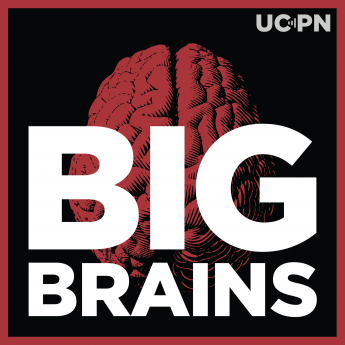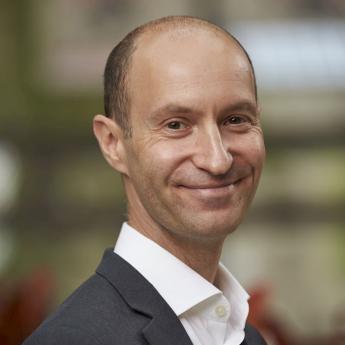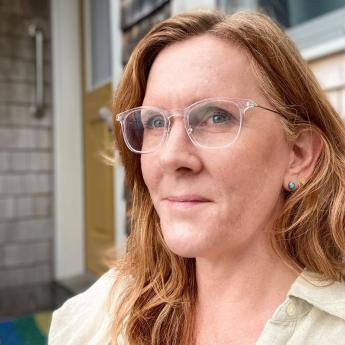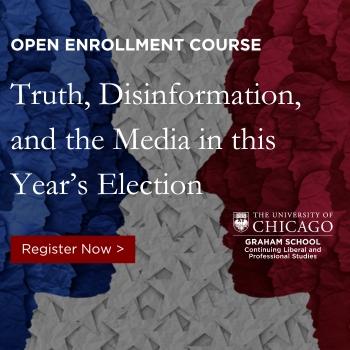Show Notes
There is a science to what we remember and what we don't. For instance, why do we remember certain pieces of artwork, some brands’ logos, or even people's faces? University of Chicago psychologist Wilma Bainbridge has been studying what makes things memorable for over a decade. Through her research, she has found that there is a common thread about what most people remember—and even what we remember incorrectly (a phenomenon called the Mandela effect)—but most recently, why some visuals are intrinsically more memorable.
Bainbridge directs the Brain Bridge Lab, where her team has created a machine learning model called ResMem, which can predict the memorability of faces, artwork and more. They have tested their AI tool in real-life settings, like the Art Institute of Chicago, with hopes that similar memorability tools could be used in educational settings, criminal justice, science and medicine.
Subscribe to Big Brains on Apple Podcasts and Spotify.
(Episode published May 13, 2024)
Subscribe to the Big Brains newsletter.
Please rate and review the Big Brains podcast.
Related:
- Forget Me Not — Chicago Magazine
- Time Slows Down When We See Something Memorable — Scientific American
- Beauty Is in the Eye of the Beholder—but Memorability May Be Universal — Wired
- Your ability to remember works of art may be predictable — UChicago News
- Can you pick out the correct version of these famous pop culture icons? — UChicago News
Transcript:
Wilma Bainbridge: Have you experienced a Mandela effect before?
Paul Rand: Not that I think that I have, no. That’s Wilma Bainbridge. She’s an assistant professor of psychology at the University of Chicago, and one of the first scientists in the world to study something called the Mandela effect.
Wilma Bainbridge: For example, do you know what the Monopoly man looks like? The character of the board game? Would you be willing to describe him to me?
Paul Rand: Top hat. I’m envisioning a top hat and maybe a monocle, and maybe there’s a dollar sign in there or something. But those are the things that just pop into my head.
Wilma Bainbridge: Most people think he has a monocle, and if I show you a picture of him with a monocle, you’ll pick that one. But he has nothing on his eyes, no monocle, no glasses.
Paul Rand: If you also remember the Monopoly man wearing a monocle, you’re not alone. It turns out there’s actually a scientific phenomena of many people all misremembering things in very specific ways.
Wilma Bainbridge: And this is an example of the Mandela effect.
Tape: No matter how smart you think you are, your mind may be playing tricks on you. A new poll shows many Americans misremember history and even pop culture.
Tape: And it’s known as the Mandela effect.
Wilma Bainbridge: Many, many people have the same false memory for something, and it originated from this idea that many people thought that Nelson Mandela died in jail in the ‘80s, when really he lived until the late 2000s as a free man. So it’s been analyzed by a lot of conspiracy theorists, researchers, anthropologists, sociologists. But nobody has studied from a psychological lens on what does this reflect about memory.
Wilma Bainbridge: So this was the first ever study of the Mandela Effect that we ran.
Paul Rand: Wow.
Wilma Bainbridge: And some of the questions are, do people really share this false memory and why? We ran a series of experiments showing that people really do show these strong Mandela Effects. It’s not because they’re not looking at the image correctly. It’s not because they’ve seen examples of it online. We’ve even shown ... If I show you a picture of the Monopoly man without the monocle, and then test you a few minutes later, you’ll still draw the monocle on the Monopoly man. So it’s really something that’s happening in a short time span within your memory.
Paul Rand: Bainbridge is a memory expert. For the past decade, her lab has been focused on trying to understand what makes something memorable. Why do certain images, logos, pieces of art stick in our minds while we totally forget others?
Wilma Bainbridge: Really, I’m interested in about how do our memories work more broadly for all sorts of things. Like my first work was on the memorability of faces. And we’ve done some work on memorability for photographs more broadly, even dance moves, words, voices.
Paul Rand: And now Bainbridge has used her research to build an AI tool that can accurately predict how memorable an image will be. It’s a stunning step forward in our understanding of memory, with huge implications.
Wilma Bainbridge: We’re really hoping that understanding why we remember certain images over others might really tell us what’s happening between seeing something and remembering something in the brain.
Paul Rand: Welcome to Big Brains, where we translate the biggest ideas and complex discoveries into digestible brain food. Big Brains, little bites from the University of Chicago Podcast Network. I’m your host, Paul Rand. On today’s episode, the science of what’s memorable and what’s not.
Paul Rand: Are you endlessly curious? The UChicago Graham School has the courses you need to feed your mind. Starting this September, the school is offering a timely course on truth and disinformation in media coverage, all in the lead up to the 2024 elections. It’s an opportunity for those who want to understand the complex dynamics at play in today’s media landscape, and how it may influence elections. Discover all our offerings and find your perfect course at graham.uchicago.edu.
Paul Rand: We’ve all had the experience of having a really profound memory about a certain event or time in our lives. It sticks in our minds, and we can recall the details of it over and over again.
Wilma Bainbridge: Memory is something from the person. Memory is like the process by which I remember something. I have a memory, I have a good memory, I have a bad memory.
Paul Rand: But even if you have a great memory, that doesn’t mean you’ll remember everything you see and experience, and vice versa. If you have a bad memory, there are still things you’re likely to remember. The concept is called memorability.
Wilma Bainbridge: Memorability is about the thing we’re trying to save into that memory. So that image is memorable, that face is memorable or forgettable. And these two things often coincide. So often you will remember something that’s memorable, but there are times where your memory might differ from what is an intrinsically memorable or forgettable image.
Paul Rand: Of course, you’ll remember the faces of people you love, the special milestones in your life and so on. But more generally, it’s not so clear cut what makes something more memorable or forgettable.
Wilma Bainbridge: Surprisingly, what’s memorable is not that intuitive. So we’ve actually run experiments, testing people’s intuitions, having them guess what’s memorable, and they do very bad at guessing what they will remember. Even, I, as someone who studied this idea of memorability for over a decade, I don’t have great intuitions about it.
Paul Rand: And so, in terms of what’s really happening inside your brain, is it activating specific centers of the brain, or is it actually almost like they’re being physically stored in our brain? How do we think about this?
Wilma Bainbridge: Our memories definitely are physically stored in our brain in some way. And one great way to look at this question is via social media apps where we’re recording our memories all the time. And this app, 1 Second Every Day was perfect to look at this question of how does a brain represent memories. Because one second is such an efficient way to store a memory.
Wilma Bainbridge: Instead of showing people the hundreds of hours of videos they’ve recorded their lives, let’s parse each day down into one second. And that’s what this app does. And so, what we did is we brought in users of this app and scanned their brains while they were watching memories they record from the app.
Wilma Bainbridge: I’ve actually been using the app for 11 years or so. And yeah, at my wedding a few years ago, I showed my entire relationship with my husband as captured by these one second clips. Anyway, but we were able to recruit people who had been using the app for up to seven years and show them their memories that they had recorded from these many years.
Wilma Bainbridge: And we discovered this new map of different content types of memory in the brain. So there was a region in the brain where we could tell when that memory happened, or how familiar were the people in the memory, or how familiar were the places in the memory. So it really seems like our memories are represented as a diverse spread of different neurons that are all connected.
Wilma Bainbridge: And one neuron doesn’t just belong to one memory. It might fire from multiple different memories, and it might code different aspects of those different memories. And it also seems like there’s different things going on in the brain for shorter term memories versus these long-term memories.
Paul Rand: Interesting.
Wilma Bainbridge: You might have this feeling like it’s hard to hold a phone number in memory, but you also have thousands of memories you won’t forget from your childhood or your family.
Paul Rand: And those memory systems don’t always work together the way you may think. Using MRI studies, Bainbridge demonstrated something surprising.
Wilma Bainbridge: One thing we’re learning is that our brains are sensitive to the memorability of an image, even when we’re not actively trying to remember it. When we’re just seeing a face and trying to categorize the gender of the face, our brain automatically is processing how memorable it is. And this happens relatively rapidly, like within a hundred to 200 milliseconds after seeing the image. It seems that we’re picking up on something our visual systems are doing to decide what do I need to prioritize to save into my memories?
Paul Rand: It turns out images have an inherent memorability to our brains regardless of what we think.
Wilma Bainbridge: Yeah, so this memorability effect was first found by my colleague Philippe Zola. And he had looked at images more generally, and he found that there were some that everyone remembered and some that everyone forgot, which means that you can think that images have this intrinsic memorability. But you might think that it might be because you can give a quick label to each image like, “Oh, that’s a living room, that’s a sink, that’s a fox,” I don’t know, “That’s a dog.” So maybe people are using these word like strategies, but you can’t really do that for faces if these are people you’ve never seen before.
Paul Rand: So Bainbridge conducted another study.
Wilma Bainbridge: My experiment that started off with faces. We showed people hundreds of faces. And you can’t come up with a quick one word label for a face on the fly. Faces are also really similar in terms of shape and general color palette. But even though faces can be very similar both in terms of visual features but also in your ability to name them, we still found that there were some faces that were memorable across people and some that were forgettable across people, which shows that this intrinsic memorability to almost anything, it really holds across faces, across anything that we look at.
Paul Rand: OK. And you looked and really thought about gender, race, age, all sorts of things that helps analyze this, didn’t you?
Wilma Bainbridge: Yeah. One of the big motivators of that study was that at that time, all of the face databases that psychologists use were really non-diverse. They were all college students, white, and they were also highly posed. So it was a very restricted non-representative data set.
Wilma Bainbridge: So we created one of the first most representative face databases by taking images that were publicly available on Google images in a way that it matches the US demographics. So that means we had diverse set of ages, races, 50-50 male/female, different levels of attractiveness, and we use this really diverse data set to test our questions about face memory. And we also tested it online with thousands of people across the U.S., so we also had diverse participants. We found that even with people’s diverse experiences, there’s some faces we all remember and some that we all forget.
Wilma Bainbridge: A lot of prior psychology work has found that there’s definitely an impact of culture on memory. So you’ll be better at remembering faces from your own country or your own race than faces from another race, for example. But one cool finding that’s come out, not from my lab but from another lab in South Korea. They’re finding that even so, the memorability of faces stays sort of like the ranking stays the same across cultures. So if I’m Korean and I’m looking at the most memorable German face, I’ll remember that better than any other German face. This other lab at UPenn has found that even monkeys are finding the same images memorable or forgettable.
Paul Rand: Unbelievable. Okay. Let’s play a little bit of celebrity game on this. And if you said, “All right, here’s some celebrity faces folks are probably familiar with and they are memorable, and then here are some that you probably know the name of, but maybe not as memorable for people to recall their faces.”
Wilma Bainbridge: We’re actually running a study just like that right now, where we’re taking celebrities from Mexico and India, and then showing them to Indian and Mexican participants to see if our celebrity face is just more memorable, even if they’re not celebrities for your culture, if that makes sense. So would Indian celebrities still be more memorable to Mexican participants and vice versa? Maybe part of what makes you famous is that you just have such a memorable face that people remember you. Casting agents, audience members all remember you.
Paul Rand: And they even showed photos of people with different levels of attractiveness. You might have this misconception that more attractive people would be much more memorable. Like celebrities, for example, but that’s not necessarily the case.
Wilma Bainbridge: In general, more attractive faces tend to cause a lot of false memories, but aren’t actually more memorable. So you can be incredibly attractive and then forgettable.
Paul Rand: And is there anything where you can say, “Here’s some things that we notice on a lot of faces that are memorable”?
Wilma Bainbridge: One interesting thing is memorability is not just one feature. And also more memorable faces, they do tend to be the ones that seem more distinctive. If you have more negative emotions, you might seem more memorable. Threatening faces tend to be more memorable. So yeah, there might be some evolutionary perspective of you need to remember your threats in the environment.
Paul Rand: So if there’s no one way to be memorable, are there advantages to being memorable looking or disadvantages to be unmemorable?
Wilma Bainbridge: Yeah, so it’s funny, when I give talks, I show pictures of the most memorable and forgettable faces from my database, and I got permission from these faces to show this.
Paul Rand: I’m sure the people that have unmemorable faces were flattered when you told them that.
Wilma Bainbridge: Yeah, actually, the most forgettable face thought it was really funny. They liked it a lot. So at first, the audience, when I give these talks, thinks it’s a great thing to be memorable and they pity the forgettable person, but I think there’s pros and cons to each.
Paul Rand: There are all sorts of situations in which being memorable could be useful. Applying for jobs, getting picked for projects, maybe even in dating.
Wilma Bainbridge: We do have a study right now that’s not yet published, but stay tuned in the next few months where we’re looking at how memorability relates to social media success. Yeah, so does something do better on social media if it’s more memorable? And it seems like the short answer is yes.
Paul Rand: But?
Wilma Bainbridge: To be memorable, that is good in that, yeah, maybe you can become a famous actor or celebrity. But also it can be problematic if people are always remembering you.
Paul Rand: For instance, having a face that is very memorable may not be useful in court.
Wilma Bainbridge: Let’s say you have a suspect who’s innocent, but causes a lot of false memories with their face.
Paul Rand: So how could we put all this memorability research to use? What Bainbridge realized was if the same faces, images, and piece of art are memorable to people, could we use that data to build an AI that could easily predict memorability? And if so, how could that change society?
Wilma Bainbridge: I come out of a computational background, and it’s really big in the field of computer vision right now to create these neural networks that can predict things about an image. And a lot of the predictions about images are what’s in the image. Like, “Oh, that’s a car on a road,” for automatic driving.
Wilma Bainbridge: But you can also predict things that are a little more abstract or complex about an image, like how attractive is the image, how humorous is the image? And because we’re interested in studying memory in the lab, we built ours to try and predict how memorable is the image.
Paul Rand: That’s after the break.
Paul Rand: Have you ever wondered who you are, but didn’t know who to ask? Well, then join Professor Eric Oliver as he poses the nine most essential questions for knowing yourself to some of humanity’s wisest and most interesting people. Nine questions with Eric Oliver, part of the University of Chicago Podcast Network.
Paul Rand: Bainbridge’s Lab has been researching memorability from different angles, but one thing they were interested in exploring was whether they could test memorability using AI. So they created a state-of-the-art machine learning model, and it’s called ResMem.
Wilma Bainbridge: Yeah, so ResMem is our artificial intelligence. It’s a neural network where you can upload a picture and it’ll tell you how memorable it thinks it is. And me and my former master student, Coen Needell built this together. We trained it on people’s memory performance from 60,000 photographs out in the real world. But we’re actually finding that it can make predictions that are pretty impressive about people’s memory beyond the sorts of tasks and images it was trained on.
Paul Rand: It turned out that ResMem was proving to be really good at making predictions.
Wilma Bainbridge: So we were then curious, well, is it good enough to predict people’s memory out in the real world? I had this amazing undergraduate join my lab, Trent Davis, and he was a neuroscience and art double major at the time. So he wanted to do something related to art, and I was sort of curious, well, art is this highly subjective image form.
Paul Rand: Yes. Yes.
Wilma Bainbridge: You think that everyone approaches a piece of art differently. We all have different feelings about a piece of art, so maybe we wouldn’t remember the same things in art. Like finally memorability would break down with artwork. So we ran an online experiment with the Art Institute’s whole collection of 4,000 paintings, and we found that online in a traditional experiment, people still remembered and forgot the same pieces of art, and we found that ResMem could predict people’s memory in this online experiment.
Paul Rand: Fascinating.
Wilma Bainbridge: So we had people visit the Art Institute of Chicago, the American Art Wing, and we had them just do a free-form visit. They could bring their friends, they could go around it in any order they wanted. The only thing we told them was to see every piece at least once, and then when they exited, we had them do a memory test on their phones. And from that we can see what are the pieces a remembered or forgot. And we found that ResMem could predict this. ResMem also found that the famous paintings in the Art Institute’s collection were more memorable than the not so famous paintings.
Paul Rand: Wow.
Wilma Bainbridge: And so, part of what makes a painting famous could be that it’s just an intrinsically memorable piece. Something about the visual features of it sticks in my memory and then causes me to tell other people to go visit it, and then that sort of creates a cultural memory for that piece and maybe helps it become famous. Even though ResMem knows only about each individual image, it knows nothing about people, like the people doing the experiment and knows nothing about the art institute, or art history, or art culture, but it could predict that they would remember this piece over this piece.
Paul Rand: Attached to the Art Institute, of course, is the School of the Art Institute. And I’m wondering, they’ll have a class on color theory. Do you imagine they’re going to start having classes on memorability theory?
Wilma Bainbridge: Oh, yeah. I haven’t chatted with them about it, but I think it would be a great idea. We actually are doing some other work that’s going to be published soon. Showing that artists might actually approach visual memory differently from non-artists, and they might actually be able to remember more things than non-artists. So maybe they do have some ability to tap into memory in a way that the average person cannot.
Paul Rand: Your mind is probably already reeling with all the possible applications for ResMem and other memorability tools beyond just the art world. They could become indispensable tools in science, education and even medicine.
Wilma Bainbridge: So I am excited about these ideas of improving educational tools. And one student in my lab is doing work on seeing how memorability of gestures made by teachers might help improve learning in children. So it’s sort of like how can you teach in a more memorable way, or make a textbook in a more memorable way to help kids learn complex math problems, or new words? Or maybe artwork in a hospital for patients with dementia? Maybe you want that artwork to be more memorable, for example.
Wilma Bainbridge: We’re also really interested in developing tools for early diagnosis of Alzheimer’s disease. So just as there are images that are really memorable, we’ve been finding there are some images that are really diagnostic that are memorable to the average person, but forgettable if you start to experience cognitive decline. And we find that you can actually tell whether someone’s experiencing cognitive decline in way fewer images when we use these diagnostic images than in a traditional memory test. Right now we’re working on developing ways to identify diagnosticity of images and maybe use that for some clinical applications in the future.
Paul Rand: But it doesn’t just stop with science, or medicine, or education. You could even imagine memorability tools being used in the criminal justice system.
Wilma Bainbridge: There’s also some potential applications in wanting to think about normalizing the memorability or false memorability of faces in a lineup. So let’s say you have a suspect who’s innocent but causes a lot of false memories with their face, then let’s pick other people in a lineup who also cause similar amounts of false memories. So now we’re planning on some follow-up studies similar to our memorability studies and ResMem studies, but now seeing can we build a neural network that can predict the false memorability of an image? And yeah, what is causing us to have some false memories over for specific images?
Paul Rand: The false memorability of an image is something Bainbridge has studied before. It’s called, again, the Mandela Effect.
Wilma Bainbridge: Some of the first work on the Mandela Effect was on looking at conspiracy theories. Many people online think that the Mandela Effect is a sign that we’ve jumped dimensions, that we lived in a world where the monopoly man had a monocle, but we’ve since jumped into a dimension where he doesn’t have a monocle.
Paul Rand: And why do I have that thought that he’s wearing a monocle? If the Mandela Effect is not necessarily idea of the quantum universes and parallel universes, what is it? Why are people having these different things? Or do we try to complete an image in our own minds and we can’t think of something, so that just comes into what we expect?
Wilma Bainbridge: Yeah, so one funny thing, but sort of sad for the conspiracy theorists is that our experiment did show evidence against this idea that we’ve jumped dimensions. Because there were some people who hadn’t heard of these icons, some people who didn’t know the Monopoly man. And so, we’d show him the Monopoly man, like a picture of the correct one, ask them to draw it from memory, and even in those cases, they would sometimes insert the monocle.
Wilma Bainbridge: So even on a short time span this can happen, and it’s unlikely we just happened to jump dimensions in the five minutes I was running the experiment. But other than that, so what is explaining this Mandela Effect? I mean, I think it’s something like this memorability effect we’re looking at, but it’s that there’s just some types of images that cause a lot of false memories. And it can be for different reasons. So one common idea is that, yeah, maybe we’re filling in information from our schemas or our previous memories.
Paul Rand: Interesting.
Wilma Bainbridge: Your image of a rich older man might be someone who has a cane and a monocle. But there’s other cases where this explanation doesn’t work. So another famous Mandela Effect is the Fruit of the Loom logo. One common false memory is that there’s a big cornucopia holding all of the fruits. And a lot of people have this strong false memory, even though cornucopias are very rare in real life, and when you see cornucopias, they’re usually with fall vegetables like squashes. This is an example where it’s unlikely people are just filling in from their own previous experiences with fruits.
Paul Rand: False memories aren’t the only way our experience of reality and memory can be malleable. Have you ever had the experience where an hour feels like half a day, even though another hour may feel just like five minutes? It turns out that this time dilation effect may have something to do with memory.
Wilma Bainbridge: Things that are hard for our brain to process feel slower because we have to dedicate a lot of resources to it. If you’re in an impending car accident, there’s so much going on that your perception of time slows down. We ran this experiment where we showed people images, and then we had them report how long did the last one feel like it took? Basically, we showed people many memorable items, and then suddenly give them a forgettable item or vice versa.
And it’s like that last item is an oddball. But to the participants, it’s all just images. They don’t know that one is an oddball. Basically, what we found is if we show you many memorable things, and then show you a forgettable thing, it feels like time has suddenly slowed down. Because it’s like memorable things are easy to process, then I give you a forgettable item, it’s harder for you to process. It bogs down your processing, and it feels like it’s slower.
Paul Rand: As we think through things that are memorable, and we’re getting used to being on these very quick TikToks and spending time on social media versus going into the museum, and studying in the way we had historically. Do all these things start impacting how we’re processing visual images and remember them?
Wilma Bainbridge: Yeah, that’s an interesting question. I do think mobile technologies have been really great for helping to support memory. So I recently had kids. I have two, twin, one-and-a-half-year-olds.
Paul Rand: Congratulations. Which one is more memorable?
Wilma Bainbridge: They’re equally memorable, but the fact that I can capture these important moments in their lives and that they can later see them, it has been really valuable. And it’s been interesting comparing this experience to my parents who now regret that they have very few videos or photos of our lives. So it’s nice that you can capture your memories in a new way. Or like with this one second everyday app. It is been great for me, looking back at the 10 years that I’ve recorded or used this app for, and surprisingly 10 years is only one hour of video footage.
Wilma Bainbridge: I mean, for all of time people have always been looking at things. Our eyes have always been open. And it’s just that our eyes are looking at different things now than they did two decades ago. And so, I’m not too worried about our visions or our memories changing as a result of social media, and the faster pace of social media.
Wilma Bainbridge: I mean, I guess this is sort of where a lot of AI and social media is headed with also filters that can make faces more attractive, and AI bots that can boost the perceived interest in products with fake likes and fake views on YouTube, right? I mean, at least on our end, we have made it so people cannot use ResMem commercially. We do have a study with Professor Akram Bakkour showing that memorability doesn’t change your decisions. So even if you’re looking at a memorable picture of a slice of pizza, it doesn’t mean you’re going to choose that slice of pizza to eat for lunch. So we’re hoping that we can really steer the usage of this work for good education in these more clinical domains.
Matt Hodapp: Big Brains is a production of the University of Chicago Podcast Network. We’re sponsored by the Graham School. Are you a lifelong learner with an insatiable curiosity? Access more than 50 open enrollment courses every quarter. Learn more at graham.uchicago.edu/bigbrains. If you like what you heard on our podcast, please leave us a rating and review. The show is hosted by Paul M. Rand, and produced by Lea Ceasrine and me, Matt Hodapp. Thanks for listening.
Episode List
The Crucial Race to Build a Better Battery with Shirley Meng (Ep. 98)
One scientist’s quest to improve technology as we transition to green energy
Do Animals Dream? with David M. Peña-Guzmán (Ep. 97)
Scholar explores the science behind animal consciousness
Extreme Heat Waves: Why Are They Surging? with Noboru Nakamura (Ep. 96)
Research examines—and could help predict—extreme weather events around the world
Why Air Pollution Is Cutting Years Off Our Lives, with Christa Hasenkopf and Anant Sudarshan (Ep. 95)
Scholars behind Air Quality Life Index report warn of threat to our global health
How tax dodging and corporate secrecy found a home in Delaware, with Hal Weitzman (Ep. 94)
Scholar examines how the wealthy, global corporations exploit tax loopholes in the tiny U.S. state
Why Countries Choose War Over Peace, with Chris Blattman (Ep. 93)
Studying gangs and political enemies, scholar tries to understand why we fight—and how to stop conflict
From green burials to DIY funerals, how death in America is changing with Shannon Lee Dawdy (Ep. 92)
Anthropologist examines what our rituals reveal about society, especially after 9/11
Why we need to invest in parents during a child's earliest years, with Dana Suskind (Ep. 91)
Book examines how better policies can bolster families and boost early childhood development
The troubling rise of antibiotic-resistant superbugs, with Christopher Murray (Ep. 90)
Global health expert warns about a potential ‘pandemic in the shadows’
Is scientific progress slowing? with James Evans (Ep. 89)
Scholar examines how researchers could generate greater innovation and discovery












